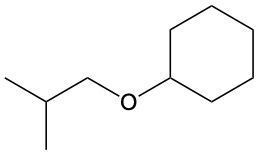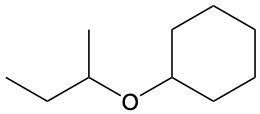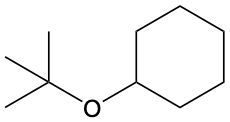In this video, we're going to take a look at naming ethers. Now recall, ethers possess an oxygen atom connected to two alkyl groups. Here we're going to say, because of this, ethers have a unique naming system. Here we'd say the parent name is ether. And the way we look at our naming system is that we're going to have our alkyl substituents. So substituent 1, substituent 2 as the beginning of the name, and then we're going to end it with ether. This is the unique approach we're going to take to naming all the types of ethers we're about to see.
- 1. Matter and Measurements4h 29m
- What is Chemistry?5m
- The Scientific Method9m
- Classification of Matter16m
- States of Matter8m
- Physical & Chemical Changes19m
- Chemical Properties8m
- Physical Properties5m
- Intensive vs. Extensive Properties13m
- Temperature (Simplified)9m
- Scientific Notation13m
- SI Units (Simplified)5m
- Metric Prefixes24m
- Significant Figures (Simplified)11m
- Significant Figures: Precision in Measurements7m
- Significant Figures: In Calculations19m
- Conversion Factors (Simplified)15m
- Dimensional Analysis22m
- Density12m
- Specific Gravity9m
- Density of Geometric Objects19m
- Density of Non-Geometric Objects9m
- 2. Atoms and the Periodic Table5h 23m
- The Atom (Simplified)9m
- Subatomic Particles (Simplified)12m
- Isotopes17m
- Ions (Simplified)22m
- Atomic Mass (Simplified)17m
- Atomic Mass (Conceptual)12m
- Periodic Table: Element Symbols6m
- Periodic Table: Classifications11m
- Periodic Table: Group Names8m
- Periodic Table: Representative Elements & Transition Metals7m
- Periodic Table: Elemental Forms (Simplified)6m
- Periodic Table: Phases (Simplified)8m
- Law of Definite Proportions9m
- Atomic Theory9m
- Rutherford Gold Foil Experiment9m
- Wavelength and Frequency (Simplified)5m
- Electromagnetic Spectrum (Simplified)11m
- Bohr Model (Simplified)9m
- Emission Spectrum (Simplified)3m
- Electronic Structure4m
- Electronic Structure: Shells5m
- Electronic Structure: Subshells4m
- Electronic Structure: Orbitals11m
- Electronic Structure: Electron Spin3m
- Electronic Structure: Number of Electrons4m
- The Electron Configuration (Simplified)22m
- Electron Arrangements5m
- The Electron Configuration: Condensed4m
- The Electron Configuration: Exceptions (Simplified)12m
- Ions and the Octet Rule9m
- Ions and the Octet Rule (Simplified)8m
- Valence Electrons of Elements (Simplified)5m
- Lewis Dot Symbols (Simplified)7m
- Periodic Trend: Metallic Character4m
- Periodic Trend: Atomic Radius (Simplified)7m
- 3. Ionic Compounds2h 18m
- Periodic Table: Main Group Element Charges12m
- Periodic Table: Transition Metal Charges6m
- Periodic Trend: Ionic Radius (Simplified)5m
- Periodic Trend: Ranking Ionic Radii8m
- Periodic Trend: Ionization Energy (Simplified)9m
- Periodic Trend: Electron Affinity (Simplified)8m
- Ionic Bonding6m
- Naming Monoatomic Cations6m
- Naming Monoatomic Anions5m
- Polyatomic Ions25m
- Naming Ionic Compounds11m
- Writing Formula Units of Ionic Compounds7m
- Naming Ionic Hydrates6m
- Naming Acids18m
- 4. Molecular Compounds2h 18m
- Covalent Bonds6m
- Naming Binary Molecular Compounds6m
- Molecular Models4m
- Bonding Preferences6m
- Lewis Dot Structures: Neutral Compounds (Simplified)8m
- Multiple Bonds4m
- Multiple Bonds (Simplified)6m
- Lewis Dot Structures: Multiple Bonds10m
- Lewis Dot Structures: Ions (Simplified)8m
- Lewis Dot Structures: Exceptions (Simplified)12m
- Resonance Structures (Simplified)5m
- Valence Shell Electron Pair Repulsion Theory (Simplified)4m
- Electron Geometry (Simplified)8m
- Molecular Geometry (Simplified)11m
- Bond Angles (Simplified)11m
- Dipole Moment (Simplified)15m
- Molecular Polarity (Simplified)7m
- 5. Classification & Balancing of Chemical Reactions3h 17m
- Chemical Reaction: Chemical Change5m
- Law of Conservation of Mass5m
- Balancing Chemical Equations (Simplified)13m
- Solubility Rules16m
- Molecular Equations18m
- Types of Chemical Reactions12m
- Complete Ionic Equations18m
- Calculate Oxidation Numbers15m
- Redox Reactions17m
- Spontaneous Redox Reactions8m
- Balancing Redox Reactions: Acidic Solutions17m
- Balancing Redox Reactions: Basic Solutions17m
- Balancing Redox Reactions (Simplified)13m
- Galvanic Cell (Simplified)16m
- 6. Chemical Reactions & Quantities2h 35m
- 7. Energy, Rate and Equilibrium3h 46m
- Nature of Energy6m
- First Law of Thermodynamics7m
- Endothermic & Exothermic Reactions7m
- Bond Energy14m
- Thermochemical Equations12m
- Heat Capacity19m
- Thermal Equilibrium (Simplified)8m
- Hess's Law23m
- Rate of Reaction11m
- Energy Diagrams12m
- Chemical Equilibrium7m
- The Equilibrium Constant14m
- Le Chatelier's Principle23m
- Solubility Product Constant (Ksp)17m
- Spontaneous Reaction10m
- Entropy (Simplified)9m
- Gibbs Free Energy (Simplified)18m
- 8. Gases, Liquids and Solids3h 25m
- Pressure Units6m
- Kinetic Molecular Theory14m
- The Ideal Gas Law18m
- The Ideal Gas Law Derivations13m
- The Ideal Gas Law Applications6m
- Chemistry Gas Laws16m
- Chemistry Gas Laws: Combined Gas Law12m
- Standard Temperature and Pressure14m
- Dalton's Law: Partial Pressure (Simplified)13m
- Gas Stoichiometry18m
- Intermolecular Forces (Simplified)19m
- Intermolecular Forces and Physical Properties11m
- Atomic, Ionic and Molecular Solids10m
- Heating and Cooling Curves30m
- 9. Solutions4h 10m
- Solutions6m
- Solubility and Intermolecular Forces18m
- Solutions: Mass Percent6m
- Percent Concentrations10m
- Molarity18m
- Osmolarity15m
- Parts per Million (ppm)13m
- Solubility: Temperature Effect8m
- Intro to Henry's Law4m
- Henry's Law Calculations12m
- Dilutions12m
- Solution Stoichiometry14m
- Electrolytes (Simplified)13m
- Equivalents11m
- Molality15m
- The Colligative Properties15m
- Boiling Point Elevation16m
- Freezing Point Depression9m
- Osmosis16m
- Osmotic Pressure9m
- 10. Acids and Bases3h 29m
- Acid-Base Introduction11m
- Arrhenius Acid and Base6m
- Bronsted Lowry Acid and Base18m
- Acid and Base Strength17m
- Ka and Kb12m
- The pH Scale19m
- Auto-Ionization9m
- pH of Strong Acids and Bases9m
- Acid-Base Equivalents14m
- Acid-Base Reactions7m
- Gas Evolution Equations (Simplified)6m
- Ionic Salts (Simplified)23m
- Buffers25m
- Henderson-Hasselbalch Equation16m
- Strong Acid Strong Base Titrations (Simplified)10m
- 11. Nuclear Chemistry56m
- BONUS: Lab Techniques and Procedures1h 38m
- BONUS: Mathematical Operations and Functions47m
- 12. Introduction to Organic Chemistry1h 34m
- 13. Alkenes, Alkynes, and Aromatic Compounds2h 12m
- 14. Compounds with Oxygen or Sulfur1h 6m
- 15. Aldehydes and Ketones1h 1m
- 16. Carboxylic Acids and Their Derivatives1h 11m
- 17. Amines38m
- 18. Amino Acids and Proteins1h 51m
- 19. Enzymes1h 37m
- 20. Carbohydrates1h 46m
- Intro to Carbohydrates4m
- Classification of Carbohydrates4m
- Fischer Projections4m
- Enantiomers vs Diastereomers8m
- D vs L Enantiomers8m
- Cyclic Hemiacetals8m
- Intro to Haworth Projections4m
- Cyclic Structures of Monosaccharides11m
- Mutarotation4m
- Reduction of Monosaccharides10m
- Oxidation of Monosaccharides7m
- Glycosidic Linkage14m
- Disaccharides7m
- Polysaccharides7m
- 21. The Generation of Biochemical Energy2h 8m
- 22. Carbohydrate Metabolism2h 22m
- 23. Lipids2h 26m
- Intro to Lipids6m
- Fatty Acids25m
- Physical Properties of Fatty Acids6m
- Waxes4m
- Triacylglycerols12m
- Triacylglycerol Reactions: Hydrogenation8m
- Triacylglycerol Reactions: Hydrolysis13m
- Triacylglycerol Reactions: Oxidation7m
- Glycerophospholipids15m
- Sphingomyelins13m
- Steroids15m
- Cell Membranes7m
- Membrane Transport10m
- 24. Lipid Metabolism1h 45m
- 25. Protein and Amino Acid Metabolism1h 37m
- 26. Nucleic Acids and Protein Synthesis2h 54m
- Intro to Nucleic Acids4m
- Nitrogenous Bases16m
- Nucleoside and Nucleotide Formation9m
- Naming Nucleosides and Nucleotides13m
- Phosphodiester Bond Formation7m
- Primary Structure of Nucleic Acids11m
- Base Pairing10m
- DNA Double Helix6m
- Intro to DNA Replication20m
- Steps of DNA Replication11m
- Types of RNA10m
- Overview of Protein Synthesis4m
- Transcription: mRNA Synthesis9m
- Processing of pre-mRNA5m
- The Genetic Code6m
- Introduction to Translation7m
- Translation: Protein Synthesis18m
Naming Ethers - Online Tutor, Practice Problems & Exam Prep
 Created using AI
Created using AIEthers are named by combining the names of their two alkyl groups followed by the term "ether." The smaller alkyl group is treated as an alkoxy substituent, which includes the oxygen atom. This naming convention aligns with IUPAC rules, emphasizing the location of substituents. Understanding this unique naming system is essential for identifying ethers in organic chemistry, as it reflects their structure and functional groups, such as the alkoxy group, which plays a significant role in their chemical behavior.
Rules for Naming Ethers Concept 1
Video transcript
Naming Ethers Example 1
Video transcript
In this example question, it asks to name the following ether compound. In order to accomplish this, we're going to utilize the following three steps. Step 1, we have to identify the two alkyl groups connected to our oxygen atom. So here is our oxygen atom, and we have this alkyl group connected to it, and this alkyl group connected to it. Here this has 1, 2, 3, 4 carbons, so this would be a butyl group, and this is only a methyl group.
Step 2: Name the two alkyl groups alphabetically as substituents. So here, we know we have a butyl and a methyl group connected to the oxygen. If there are identical alkyl groups, use the numerical prefix "di." Here they are not the same, so we don't have to say like "dimethyl" or "dibutyl." So we're going to say here, butyl, methyl.
Step 3: End the name of the compound with "ether," and then write the name with spaces. So there's a space between butyl and methyl, and then the end of the name ether. So this would be butyl methyl ether.
Provide the name for the following ether.
tert-butyl pentyl ether
sec-butyl pentyl ether
sec-butyl pentanoate
pentyl sec-butyl ether
Which structure represents isobutyl propyl ether?
IUPAC Rules for Naming Ethers Concept 2
Video transcript
The IUPAC rules for naming ethers are very similar to naming alkanes with substituents. Here we're going to say that the smaller alkyl group is treated as an alkoxy substituent. Now, what's an alkoxy substituent? Well, that's just the smaller alkyl group combined with the oxygen atom. Here, the naming convention will be the location of our substituents, one of them being an alkoxy substituent, and then the parent name. So, these are the approaches we're going to take when coming to name these ethers under the IUPAC naming system.
IUPAC Rules for Naming Ethers Example 2
Video transcript
Give the systematic name for the following ether. Now, here, step 1 is we have to identify the two alkyl groups connected to the oxygen atom. And we're going to say that the larger alkyl group is assigned the parent name according to the prefixes. So if we take a look at this ether, this side here has a total of four carbons involved. So if we look, we have four carbons involved here, and this side only has two. So, it's going to be the one on the left side that's going to form the parent name. Step 2 is we have to assign names to all substituents.
Alright. So, the way we're going to look at this is this side has the most carbons involved, but we still have to operate along the whole idea of substituents and the longest chain. We're going to say that the smaller alkyl by default will become the alkoxy substituent, and it'll be connected to the oxygen. So here, this is a substituent for us. So this is a substituent. And we have to look and see what the longest carbon chain is. The longest carbon chain is 123, which would mean that this up here is also a substituent.
Right, so we have two substituents on a three-carbon chain. Alright, so start numbering the chain from the, we're going to say the closest substituent. If a tie between substituents compare the next closest substituent, there was no tie because if we made this carbon 1, that's because the substituent's already here. If we made this 1, we'd have to go 12 before we get to a substituent. Right now, if still a tie, then number in alphabetical order, which we didn't need to do.
Alright. So we have our structure here. Again, this is a substituent, and this becomes a substituent. And then we repeat steps from naming alkanes with substituents. So coming back up here, We're going to say that this is a one-carbon substituent, so this is a methyl. This here is an alkoxy substituent since it's combined with the oxygen. A 2-carbon substituent is ethyl, but it's no longer an ethyl because it's combined with the oxygen, so it becomes an ethoxy.
Alright. So now we're going to say that the longest carbon chain is three carbons long, three carbons long is propane. And then the two substituents e come before m. So on carbon 1, we have an ethoxy. On carbon 2, we have a methyl. So this would be 1-ethoxy-2-methylpropane. This will be the name of this following ether.
Provide both the common and IUPAC name for the following ether.
dipropyl ether; 1-propoxypropane
dibutyl ether; 1-butoxybutane
dipropyl ether; 2-propoxypropane
dibutyl ether; 2-butoxybutane
What is the IUPAC name of isobutyl propyl ether?
2-methyl-1-propoxypropane
2-methyl-1-propanepropoxy
3-methyl-1-propoxybutane
2-dimethyl-1-propoxyethane
Which structure represents isobutoxycyclohexane?
Do you want more practice?
Here’s what students ask on this topic:
What is the general naming convention for ethers?
The general naming convention for ethers involves naming the two alkyl groups attached to the oxygen atom, followed by the word 'ether.' For example, if you have an oxygen atom connected to a methyl group (CH3) and an ethyl group (C2H5), the ether would be named methyl ethyl ether. This method is straightforward and helps in identifying the structure of the ether based on its name.
 Created using AI
Created using AIHow do you name ethers using IUPAC rules?
Under IUPAC rules, ethers are named by treating the smaller alkyl group as an alkoxy substituent. This means you combine the smaller alkyl group with the oxygen atom to form the alkoxy group. For example, if you have an ether with a methoxy group (CH3O-) and a butane chain (C4H9), it would be named methoxybutane. The location of the alkoxy substituent is also specified if necessary, such as 1-methoxybutane.
 Created using AI
Created using AIWhat is an alkoxy substituent in the context of naming ethers?
An alkoxy substituent in the context of naming ethers is the smaller alkyl group combined with the oxygen atom. For example, in methoxyethane (CH3OCH2CH3), the methoxy group (CH3O-) is the alkoxy substituent. This group is treated as a substituent on the larger alkyl chain, and its position is indicated in the name if necessary.
 Created using AI
Created using AIWhy is it important to understand the naming system for ethers?
Understanding the naming system for ethers is crucial because it allows chemists to accurately identify and communicate the structure of these compounds. Ethers have unique chemical properties and reactivity due to the presence of the oxygen atom, and knowing their names helps in predicting their behavior in chemical reactions. Additionally, proper naming is essential for writing scientific papers, lab reports, and for effective communication in the field of organic chemistry.
 Created using AI
Created using AICan you provide an example of naming an ether with two different alkyl groups?
Sure! Let's consider an ether with a methyl group (CH3) and a propyl group (C3H7). According to the general naming convention, this ether would be named methyl propyl ether. If we use the IUPAC naming system, the smaller alkyl group (methyl) is treated as an alkoxy substituent, resulting in the name methoxypropane.
 Created using AI
Created using AIYour GOB Chemistry tutor
- Name the following compounds:a. <IMAGE>b. <IMAGE>c. <IMAGE>
- Name all unbranched ether and alcohol isomers with formula C5H12O and write their structural formulas.
- Draw structures corresponding to the following names:c. Phenyl tert-butyl ether
- What is the structural relationship between a thiol and an alcohol?
- Draw structures corresponding to the following names:e. 2,4-Dimethoxy-3-methylpentane
- Name the following compounds:c. <IMAGE>d. <IMAGE>
- Draw the structural formulas of the following compounds:2-Methoxy-2-methylpropane
- Give the common name for each of the following:a. CH₃−CH₂−CH₂−O−CH₂−CH₂−CH₃
- Draw the condensed structural formula, or line-angle formula if cyclic, for each of the following:b. cyclobuty...
- Draw the condensed structural formula, or line-angle formula if cyclic, for each of the following:c. 1-propane...
- Give the common name for each of the following:a. CH₃−CH₂−O−CH₂−CH₂−CH₃
- Draw the condensed structural formula, or line-angle formula if cyclic, for each of the following:b. cycloprop...
- Draw the condensed structural or line-angle formula for each of the following: (12.1)c. methyl propyl ether










